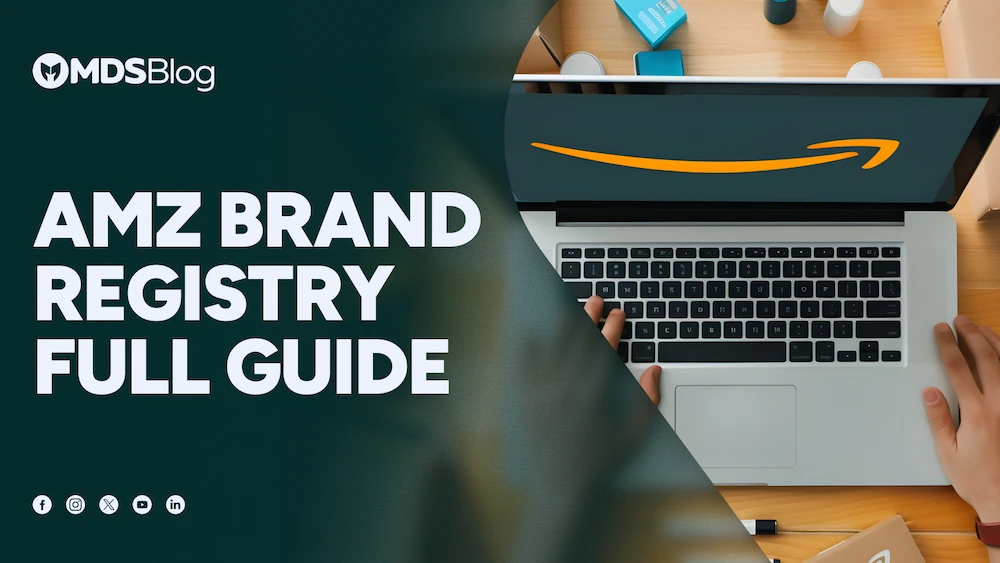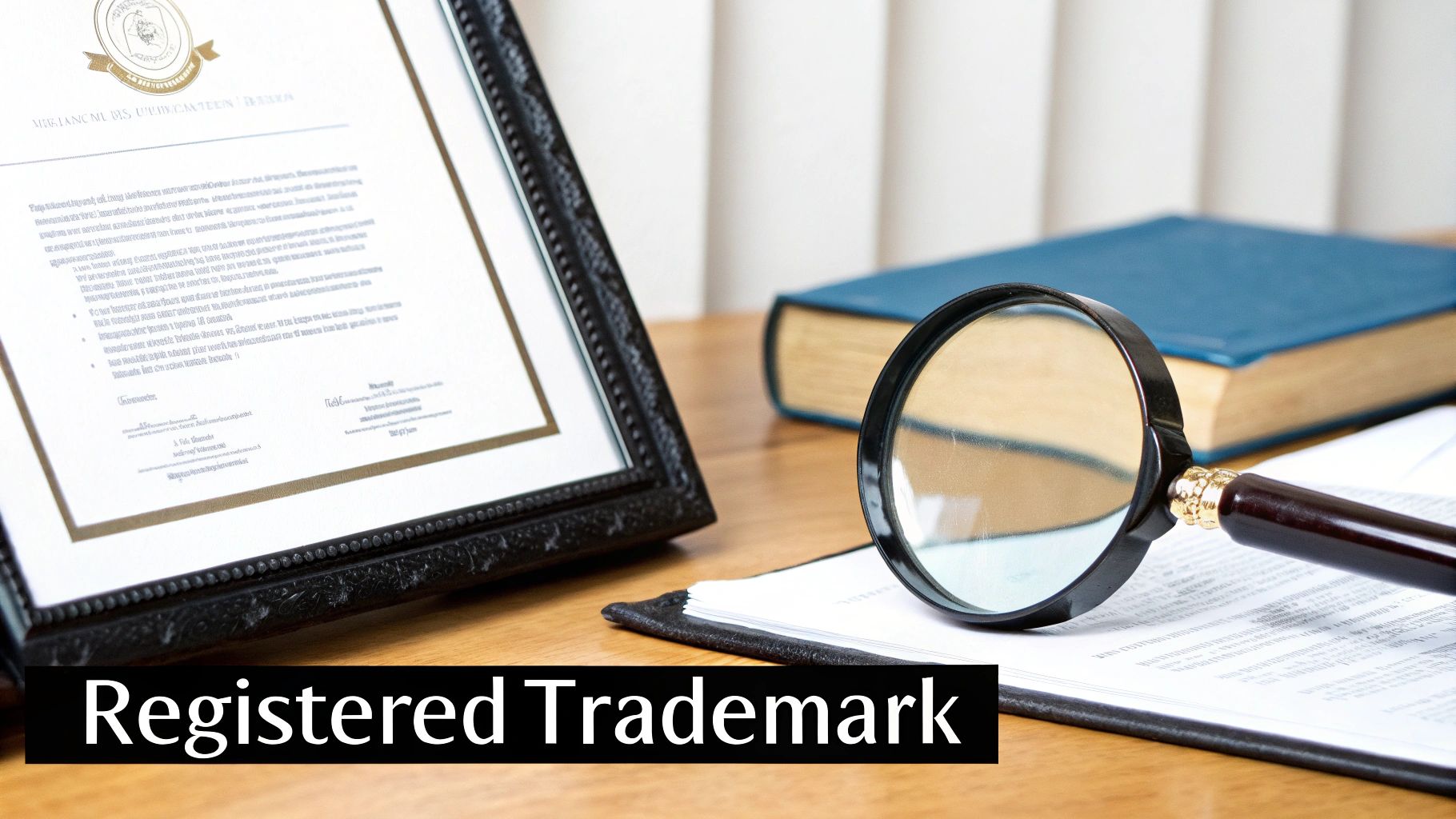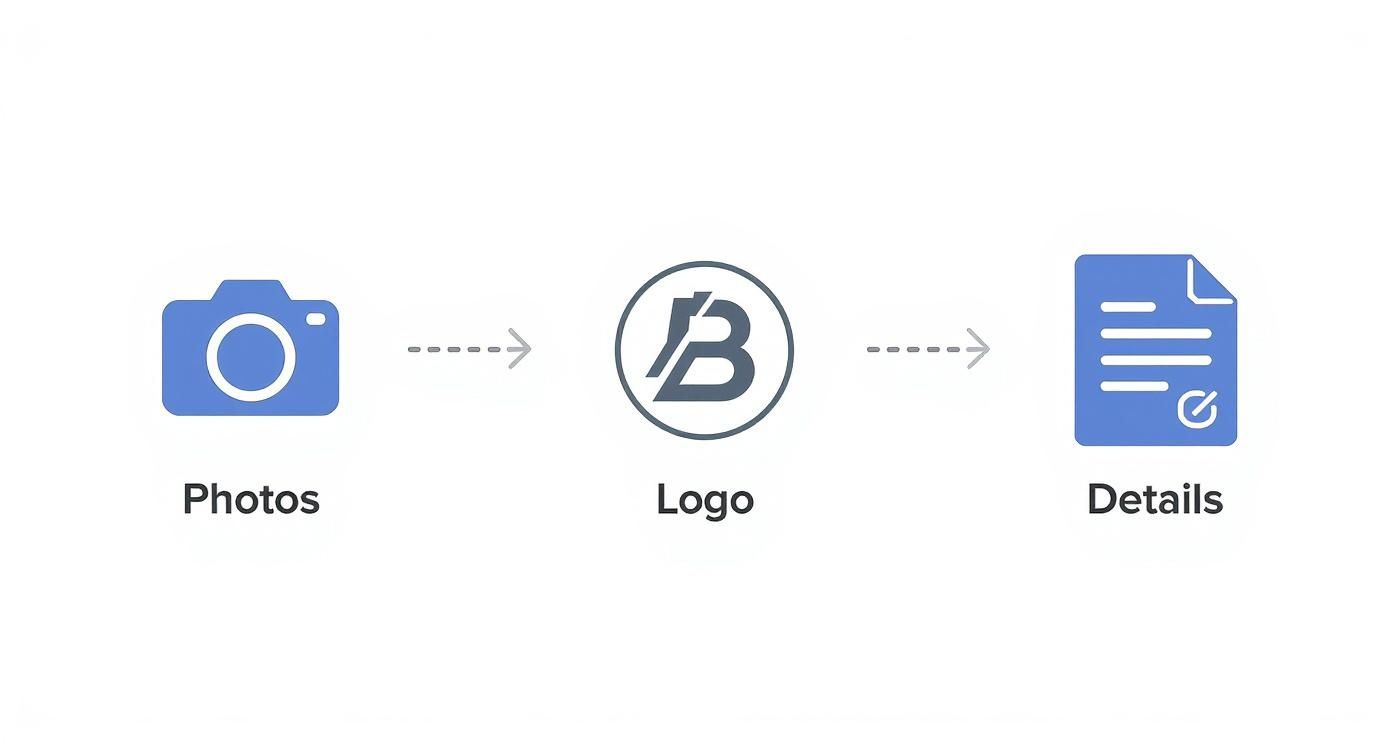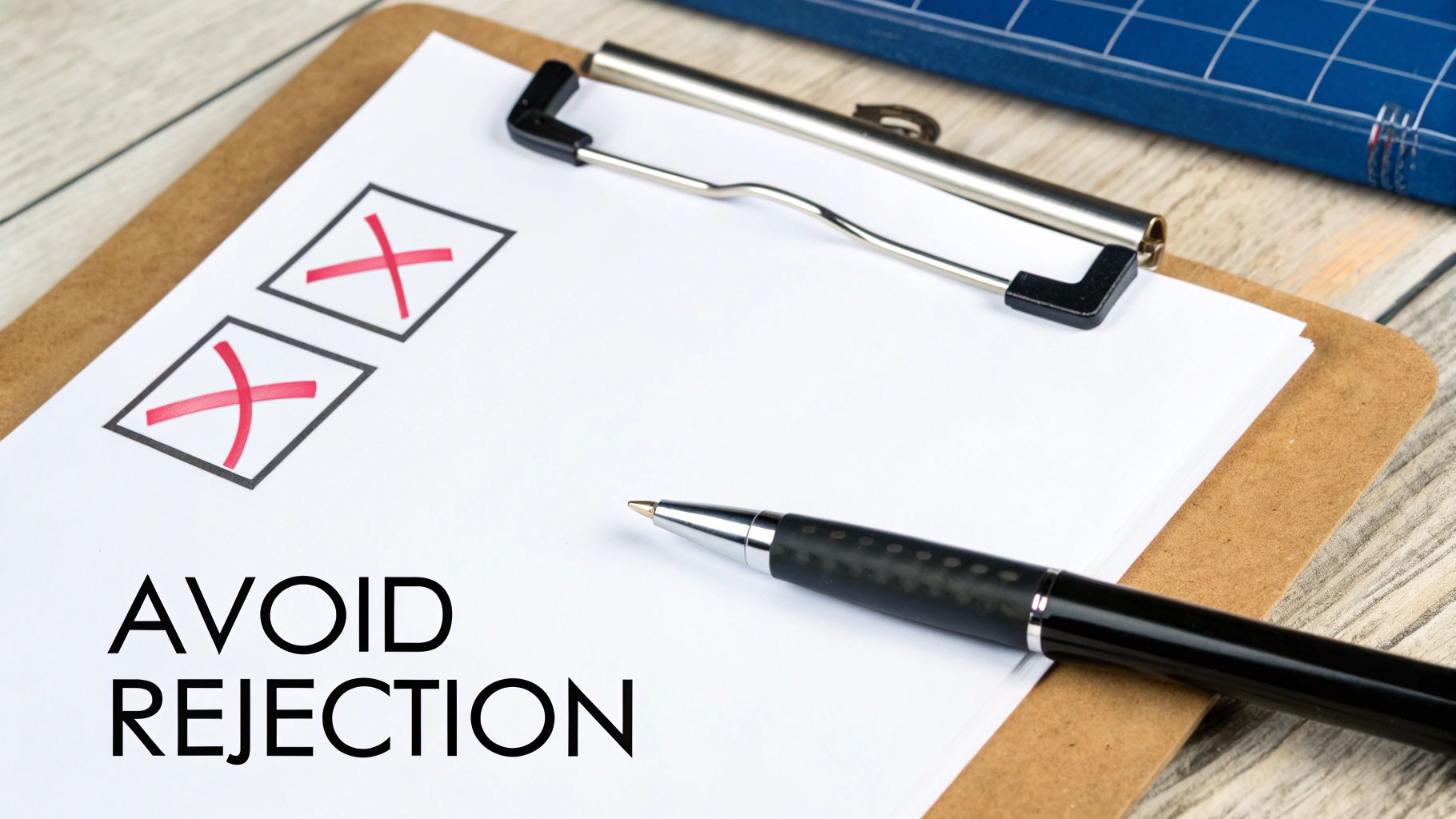Stay Updated with Everything about MDS
Thank you! Your submission has been received!
Oops! Something went wrong while submitting the form.

Chilat Doina
November 5, 2025
The whole point of the Amazon Brand Registry requirements boils down to one thing: a valid, registered trademark. Whether it's for your brand name or your logo, this is your golden ticket. Without it, you’re locked out of some of the most powerful brand protection and marketing tools on the entire platform.
Picture this: you've poured months, maybe even years, into building a brand you're proud of. Then, one day, you find a flood of counterfeiters selling cheap knockoffs under your hard-earned name. It's a seller's worst nightmare, a fast track to eroding customer trust and watching your sales vanish.
Meeting the Amazon Brand Registry requirements isn't just about ticking off boxes on a form. It's about building a digital fortress around your business.
Think of Brand Registry as the official deed to your digital property on Amazon. It gives you the authority to control your product listings, kick off unauthorized sellers, and fiercely protect your intellectual property. It’s a massive strategic advantage that shifts your brand from being a vulnerable target to a protected asset.
Getting into the Brand Registry isn't just about playing defense against hijackers and copycats. It unlocks a whole suite of exclusive tools designed to make your brand pop and drive more sales. Honestly, these benefits are the real reason why jumping through the hoops is so worth it.
Here’s a quick rundown of what you get:
This screenshot from Amazon's own Brand Services portal nails the core promise: they want to help you build and protect your brand.

It’s all about giving you the controls to manage your brand's identity and integrity yourself.
The enrollment process has to be tough enough to keep the bad actors out, but it's still very accessible for legitimate brand owners. And the scale of this protection is just massive. As of 2025, Amazon reports that more than 2.5 billion product units have been verified as genuine through the Brand Registry program. That number alone shows you the kind of impact it's having.
Brand Registry is not just a defensive measure; it's an offensive strategy. It gives you the power to define your brand's narrative, build customer loyalty, and ultimately, grow your business on your own terms.
To really appreciate these benefits, think about how much work goes into building a brand from the ground up. For example, knowing the best strategies for starting an online jewelry business is one thing, but protecting that delicate brand from day one is what ensures its survival. By getting a handle on the Amazon Brand Registry requirements, you’re not just following rules—you’re securing your brand’s future on the biggest marketplace in the world.
To bring it all together, let's look at the direct value Brand Registry brings to your business. This table breaks down the core features and shows how they translate into real, tangible results.
Feature/BenefitImpact on Your BusinessComplete Listing AuthorityPrevents listing hijacking and ensures your product information is always accurate, building customer trust.Proactive Counterfeit RemovalAutomated systems stop fakes in their tracks, protecting your revenue and brand reputation.A+ Content & Amazon StoresIncreases conversion rates by allowing you to create rich, visually appealing product pages and a dedicated storefront.Advanced Reporting ToolsProvides powerful data on customer behavior and potential infringement, helping you make smarter decisions.Access to Amazon VineHelps you generate early, credible reviews for new products, giving them a crucial launch-day boost.
Ultimately, each of these features is a tool designed not just to protect, but to actively grow your brand. It’s an ecosystem that gives serious sellers the upper hand.
Before we get tangled up in checklists and application forms, let's talk about the absolute cornerstone of this entire process: an active, registered trademark.
Think of it as your brand's official, government-issued ID. Just like you need a driver's license to prove who you are, Amazon needs to see a registered trademark to verify your brand's identity. Only then will they hand over the powerful tools that come with Brand Registry.
Without this single piece of intellectual property, your application is dead on arrival. It’s the non-negotiable foundation for everything else.

This is where a lot of sellers trip up. Amazon is extremely specific here—for the standard application path, your trademark has to be fully registered and active. A "pending" application just won't cut it.
Trying to apply with a pending trademark is one of the fastest ways to get your application rejected. That said, there is a clever shortcut we’ll get to in a minute—the Amazon IP Accelerator program.
When you go to file a trademark, you have two main options. The one you pick really matters for how your brand is protected down the line.
So, which one do you go with? For most sellers, starting with a word mark is the smartest move. It gives you solid protection for your brand name, which is what counterfeiters and copycats are most likely to steal. You can always circle back and file for a design mark to protect your logo later on.
Getting this right from the start is crucial. You can explore a great guide on how to trademark a logo and protect your brand to make sure you're on the right track.
Amazon Brand Registry isn't a one-and-done global deal. It operates on a country-by-country basis.
What does that mean? If you want to protect your brand on Amazon.co.uk, you need a trademark from the United Kingdom's Intellectual Property Office (UKIPO). To get protection on Amazon.de, you'll need one from the German office or the European Union's (EUIPO).
Amazon accepts trademarks from government offices all over the world, including the big ones:
If you're selling internationally, this is a big deal. You have to secure a separate, valid trademark for each marketplace where you want to enroll in Brand Registry. For a deeper dive into this complex but vital area, check out our guide on how to protect intellectual property.
Okay, so what if you need Brand Registry protection now, but your trademark is still stuck in that long "pending" phase?
This is exactly why Amazon created the IP Accelerator program.
It’s a fantastic workaround. By working with an Amazon-approved law firm to file your trademark application, you can get early access to Brand Registry's protection and brand-building tools. This is the only approved method to get in the door with a pending trademark.
While your application crawls through the official government process, you can start protecting your listings right away. For new brands trying to fend off hijackers and counterfeiters from day one, this program is an absolute game-changer.
Okay, so you've got your registered trademark in hand. Nice work! Now it's time to gather the rest of your paperwork for the Amazon Brand Registry application. I like to think of this as building a case file to prove you own your brand. Getting everything lined up perfectly before you start the application is the single best way to avoid getting stuck in a frustrating back-and-forth with Amazon.
This isn't just about checking off boxes. Amazon really does scrutinize every document you send over to make sure your brand is the real deal. A messy, incomplete submission can get you flagged as a non-serious seller, but a tight, well-organized application package paves the way for a quick approval.
Let's walk through exactly what you need to have ready to go.
Before you even think about opening the Brand Registry portal, do yourself a favor: create a new folder on your desktop and pull all these items into it. This one small step will save you a massive headache later.
This is the hurdle where I see so many sellers trip and fall. Amazon needs to see clear, real-world photos showing your brand name or logo permanently affixed to your actual products or packaging. This is their #1 method for weeding out resellers who just buy generic junk and slap a sticker on it.
That term—"permanently affixed"—is the key. It’s not a suggestion; it’s a hard rule. It means your branding is part of the product itself and can't just be peeled off or removed after it leaves the factory.
Amazon's Logic: They see permanent branding as proof that you're a legitimate brand owner who has actually invested in creating a unique product, not just some opportunist trying to game the system.
So, what does that look like in the real world?
What Amazon LOVES to See (Passes the Test):
What Amazon HATES to See (Fails the Test):
Every piece of evidence you submit needs to tell the same, consistent story. The brand name in your photos has to match the one on your trademark registration exactly. For instance, if your trademark is for "AquaFlow," your product photos can't show "Aqua Flow" with a space. They're usually cool with capitalization differences, but the words and spelling must be identical.
This kind of attention to detail is more than just an application requirement; it's the foundation of a strong brand. A great next step is to learn how to create brand guidelines. This will help you keep your logo, colors, and fonts consistent everywhere, from your Amazon Storefront to your Instagram feed.
By carefully preparing these documents and truly understanding the "why" behind rules like the "permanently affixed" one, you show Amazon you're a professional and credible partner. This prep work is your best shot at getting approved on your first try and unlocking all the powerful tools Brand Registry offers.
Okay, you’ve got your trademark sorted and your documents in a neat pile. Now it's time to actually tackle the Brand Registry enrollment portal. Think of this section as your co-pilot, guiding you click-by-click through the application itself. We’re going to break it all down so there’s absolutely no guesswork involved.
The whole process is pretty logical. You’ll start by preparing your key assets—things like your best product photos and your logo—before diving in to punch in the specific details Amazon needs to see.

This visual really sums up the essentials you need before you even start: high-quality photos of your product, your official logo, and all your brand details ready to go.
Follow this guide, and you’ll be able to submit your application with confidence, knowing you’ve dotted all the i's and crossed all the t's.
First things first, you need to head over to the Amazon Brand Services website. This is where you’ll kick off the whole enrollment process by creating an account specifically for Brand Registry.
Here’s a critical tip: use the exact same login credentials as your Seller Central or Vendor Central account. This is how you link everything together, making sure all the powerful brand tools and protections show up right inside your seller dashboard once you get the green light.
Even if you aren't selling on Amazon yet, you can still create an account. It gives you access to protective features like the "Report a Violation" tool, which is a nice perk.
Once you're logged in, you'll see a big button that says "Enroll a new brand." Go ahead and click it. This takes you to the main application form where you’ll need to input the core information that proves you’re the real owner of the brand.
You have to be incredibly meticulous here. This part is where Amazon's automated checks can easily trip you up for simple mistakes.
This is the key that unlocks the rest of the application. It’s all about confirming your registered trademark is legit.
With the legal stuff out of the way, Amazon now wants a bit more context about your brand and what you sell. You'll select your product categories (like "Apparel" or "Electronics") and—most importantly—provide photos that prove your brand exists in the real world.
As we covered earlier, these images absolutely must show your brand name or logo permanently affixed to the product or its packaging. I can't stress this enough: stickers and removable tags won't cut it and will be rejected. And make sure you're using photos of actual, physical items. Digital mockups are a no-go.
After you hit submit, the final—and most unique—step kicks off. Amazon will now reach out directly to the official contact listed on your trademark filing. This is usually the "trademark correspondent"—often the attorney or law firm who filed the trademark for you.
Amazon sends this correspondent a one-of-a-kind verification code. It's now up to you to get in touch with them, retrieve that code, and plug it back into Amazon through your case log to finalize everything.
This is Amazon’s ultimate security check. It's their way of confirming that the person applying for Brand Registry is undeniably connected to the legal owner of the trademark. If you used a law firm, it's a good idea to give them a heads-up that this code is on its way so they can send it over to you as soon as they get it.
Once you submit that code, your work is done. Amazon will do one last review, and soon you’ll get that sweet email confirming your successful enrollment. Welcome to a whole new level of control and protection for your brand on Amazon.
Knowing the Amazon Brand Registry requirements is one thing, but sidestepping the common mistakes that get applications rejected is another skill entirely. Submitting your application is an exciting step, but a rejection email can send you right back to square one, wasting valuable time and energy. Think of this as your guide to spotting and fixing the most frequent errors before they ever become a problem.
By learning what trips up other sellers, you can dramatically increase your chances of getting approved on the very first try. Let's break down the most common pitfalls and their straightforward solutions.

One of the most frequent—and easily avoidable—mistakes is a mismatch between the brand name on your application and the name on your official trademark filing. Amazon's verification system is extremely literal. Even a tiny discrepancy can trigger an automatic rejection.
Patience is a virtue, especially when it comes to trademark registration. A lot of eager sellers apply the moment they file their trademark, only to be met with a swift rejection. Unless you're using the Amazon IP Accelerator program, a "pending" status just won't cut it for a standard application.
Key Takeaway: An application rejection isn't the end of the world, but it does create a delay. Repeated rejections for the same issue could flag your account, so it’s crucial to resolve the specific problem before reapplying.
This one is a massive hurdle. Amazon needs undeniable proof that you are a legitimate brand, not just a reseller putting a sticker on a generic product. The "permanently affixed" branding rule is where many applications fall short. Getting this wrong can lead to serious consequences, and in some cases, you may even need guidance on what to do if you find your Amazon account suspended.
The photos you submit are your primary evidence. They must clearly show your brand name or logo as an inseparable part of the product or its packaging.
By treating your application like a professional audit and making sure every detail is perfect, you can sail through the process. The table below recaps these common rejection reasons and how to stay ahead of them.
Here’s a quick-glance table breaking down the most common application killers and the simple, proactive steps you can take to make sure your submission is flawless.
Common MistakeWhy It HappensHow to Avoid ItTrademark Name MismatchThe application name does not exactly match the trademark filing.Copy and paste the brand name directly from your trademark certificate. Check every space and symbol.Using a Pending TrademarkApplying before the trademark is fully registered (without using IP Accelerator).Wait for full registration or use the Amazon IP Accelerator program for early access.Non-Permanent BrandingPhotos show stickers, hangtags, or easily removed branding.Ensure your logo is printed, engraved, or sewn onto the product or packaging and take clear photos.Incorrect Trademark InfoA typo in the trademark registration number or selecting the wrong IP office.Double- and triple-check your registration number and confirm the correct government trademark office.
Ultimately, a successful application comes down to precision and preparation. Nail these details, and you'll be well on your way to getting approved without any headaches.
Even with a perfect roadmap, a few questions always seem to pop up right when you’re ready to hit “go.” This last section is all about tackling those common, nagging questions sellers have about getting into the Amazon Brand Registry. Think of it as your final checklist to clear up any confusion before you dive in.
We’ve pulled these directly from the most frequent sticking points we see, so you can get straight, actionable answers.
This is the big one, and the answer is a classic "yes and no."
For the standard, direct application, the answer is a hard no. Amazon is pretty black-and-white on this: they want to see a fully registered, active trademark before they’ll let you in the door. A pending application, which can easily sit in limbo for months, just won't cut it for the main enrollment path.
But here’s the good news—there's a fantastic workaround: the Amazon IP Accelerator program.
This program is the official shortcut designed for exactly this scenario. When you hire an Amazon-vetted law firm through their network to file your trademark, they grant you early access to Brand Registry’s most critical features while your trademark is still pending. It’s the only legitimate way to bypass the "fully registered" rule and start protecting your brand from counterfeiters on day one.
This is where so many applications go wrong. "Permanently affixed" means your brand name or logo has to be an integral part of the product or its packaging. It can’t be something you can just peel off, remove, or change after the fact.
Why is Amazon so strict about this? They use it as a litmus test. It proves you're a real brand that has invested in custom production, not just a reseller slapping a sticker on a generic product from Alibaba.
Let’s make this crystal clear with some real-world examples:
When you take your photos for the application, make sure they scream "permanent."
Getting that rejection email is a gut punch, but it’s rarely the end of the story. The absolute first thing you need to do is read the denial notice from Amazon very, very carefully. They should tell you exactly what went wrong.
Whatever you do, do not reapply immediately. That’s a rookie mistake that almost guarantees another rejection and can get you stuck in a frustrating loop.
Instead, zero in on the specific problem they pointed out and fix it. Common culprits are a mismatch with your trademark information, blurry photos that don’t clearly show your permanent branding, or a verification issue with your trademark attorney. Once you’ve genuinely solved the issue—whether that means taking new pictures, waiting for your trademark to officially register, or getting your lawyer to respond to Amazon—then you can resubmit your application with confidence.
Yes, and this is non-negotiable for any brand thinking about selling internationally. Brand Registry protection is 100% country-specific. Your enrollment and all its benefits are tied directly to the marketplace where you applied.
In simple terms: a US trademark protects your brand on Amazon.com. It does absolutely nothing for you on Amazon.co.uk, Amazon.de, or Amazon.jp. To get Brand Registry benefits in another country, you must have a registered trademark from that country's specific intellectual property office.
This means you have to be strategic about your global expansion. Want to enroll on Amazon.co.uk? You'll need a trademark from the UK's Intellectual Property Office (UKIPO). Planning a launch on Amazon.de? You’ll need one from the German Patent and Trade Mark Office (DPMA) or a broader one from the European Union Intellectual Property Office (EUIPO). This is a foundational step in building a truly protected global brand on Amazon.
Navigating the complexities of Amazon is a constant challenge, but you don't have to do it alone. The Million Dollar Sellers community is an exclusive, invite-only network where the world's top e-commerce founders share what's working right now. Join a trusted circle of 7, 8, and 9-figure sellers to scale faster and smarter. Learn more at https://milliondollarsellers.com.
Join the Ecom Entrepreneur Community for Vetted 7-9 Figure Ecommerce Founders
Learn MoreYou may also like:
Learn more about our special events!
Check Events